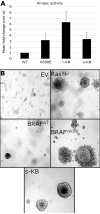Tandem duplication producing a novel oncogenic BRAF fusion gene defines the majority of pilocytic astrocytomas
- PMID: 18974108
- PMCID: PMC2577184
- DOI: 10.1158/0008-5472.CAN-08-2097
Tandem duplication producing a novel oncogenic BRAF fusion gene defines the majority of pilocytic astrocytomas
Abstract
Brain tumors are the most common solid tumors of childhood, and pilocytic astrocytomas (PA) are the most common central nervous system tumor in 5 to 19 year olds. Little is known about the genetic alterations underlying their development. Here, we describe a tandem duplication of approximately 2 Mb at 7q34 occurring in 66% of PAs. This rearrangement, which was not observed in a series of 244 higher-grade astrocytomas, results in an in-frame fusion gene incorporating the kinase domain of the BRAF oncogene. We further show that the resulting fusion protein has constitutive BRAF kinase activity and is able to transform NIH3T3 cells. This is the first report of BRAF activation through rearrangement as a frequent feature in a sporadic tumor. The frequency and specificity of this change underline its potential both as a therapeutic target and as a diagnostic tool.
Figures



References
-
- Central Brain Tumor Registry of the United States . Statistical Report: Primary Brain Tumors in the United States, 1998-2002. CBTRUS; Chicago, IL: 2006.
-
- Dirven CM, Mooij JJ, Molenaar WM. Cerebellar pilocytic astrocytoma: a treatment protocol based upon analysis of 73 cases and a review of the literature. Childs Nerv Syst. 1997;13:17–23. - PubMed
-
- Zattara-Cannoni H, Gambarelli D, Lena G, et al. Are juvenile pilocytic astrocytomas benign tumors? A cytogenetic study in 24 cases. Cancer Genet Cytogenet. 1998;104:157–60. - PubMed
Publication types
MeSH terms
Substances
Grants and funding
LinkOut - more resources
Full Text Sources
Other Literature Sources
Medical
Molecular Biology Databases
Research Materials
Miscellaneous

